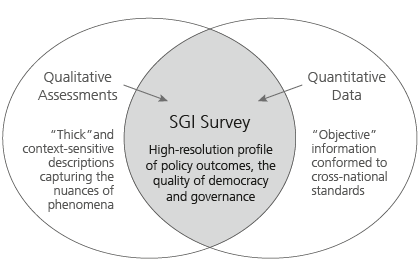Methodology
Why are qualitative assessments and quantitative data combined?
To operationalize and measure the concepts described in the Mission Statement, the SGI relies on a combination of qualitative assessments by country experts and quantitative data from official sources. Neither is fully interchangeable with the other, nor is one inherently superior. Both types of observations have specific strengths:


How is subjective bias addressed?
The assessments provided by the SGI’s Expert Network, while inherently subjective, undergo a six-stage peer review within a structured framework. This process is designed to ensure the validity and reliability of the evaluations.
What steps are involved in the qualitative assessment process?

Country experts complete the Questionnaire by providing scores and drafting a comprehensive country report.
A reviewer evaluates the draft report, offering comments and additional input. They also assign scores for each indicator independently, without access to the country experts’ original scores.
A regional Coordinator reviews the report and its scores from a regional perspective, working with experts to refine them as needed. The coordinator also oversees the data collection process for up to five countries.
Sectoral experts specializing in democratic accountability, governance foresight, and economic, social and environmental sustainability review the report and scores, providing cross-country analysis and commentary.
Regional coordinators, sectoral experts and the SGI team convene to compare and calibrate results across regions.
In a final step, the SGI’s scientific advisory board reviews the validity of the findings.
Final reports are available at sgi-network.org.
A reviewer evaluates the draft report, offering comments and additional input. They also assign scores for each indicator independently, without access to the country experts’ original scores.
A regional Coordinator reviews the report and its scores from a regional perspective, working with experts to refine them as needed. The coordinator also oversees the data collection process for up to five countries.
Sectoral experts specializing in democratic accountability, governance foresight, and economic, social and environmental sustainability review the report and scores, providing cross-country analysis and commentary.
Regional coordinators, sectoral experts and the SGI team convene to compare and calibrate results across regions.
In a final step, the SGI’s scientific advisory board reviews the validity of the findings.
Final reports are available at sgi-network.org.
How are scores weighted and aggregated?
Combining the qualitative expert ratings with quantitative data yields the Survey Structure. In order to aggregate the indicators into composite indices, the quantitative indicators (which use varying scales and units of measurement) are standardized via a linear transformation. Long-term data series were used to set appropriate minimum and maximum values and calculate scores from 1 (worst) to 10 (best).
To see the weighting schemes applied, go to Democratic Government, Governing with Foresight or Sustainable Policymaking. On these pages, you also can apply your own weighting schemes (”My Ranking”).
To see the weighting schemes applied, go to Democratic Government, Governing with Foresight or Sustainable Policymaking. On these pages, you also can apply your own weighting schemes (”My Ranking”).